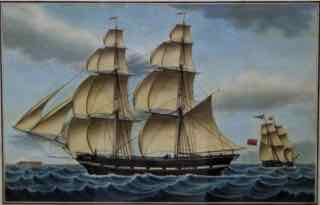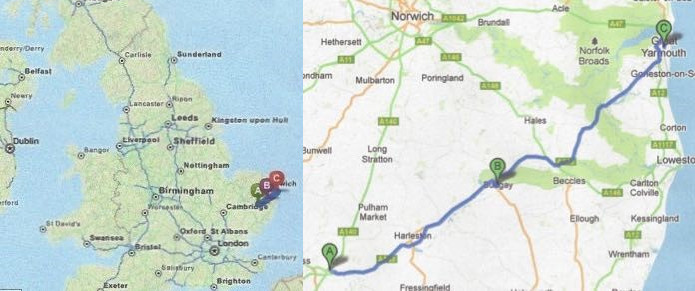 Family Stories
Family Stories
» Show All «Prev 1 2 3 4 5 6 7 8 ... 44» Next» » Slide Show
1831 The Adventure Begins

Painting of a Brig, used in the 1830s

Throughout Britain during the 1820s, ‘industrial revolution’ was transforming society. Machines were increasingly displacing the vital work of labourers. As a result, social stresses and economic hardship ensued, affecting large sections of the population, especially in rural areas.
It is hard to say what prompted James Worts and his brother-in-law, William Gooderham to plan to uproot their families and move to the ‘new world’ from the Suffolk/Norfolk region of Britain. Were they feeling the pressures of profound societal change, or were they simply following their adventurous spirits that locked onto a vision of the great potential of life in Muddy York? Perhaps it was a bit of both. We may never know for certain. But what we do know is that, in 1830/31, Worts and Gooderham developed a plan to move their families across the Atlantic in order to build and operate a windmill on the shores of Lake Ontario. With Worts’ skills as a successful miller in the community of Bungay, Suffolk, and with Gooderham’s head for business, as well as money to invest, they formed a strong partnership.
As the plan evolved, James Worts, along with his eldest son, James Gooderham Worts (not quite 13 years old), would sail from Great Yarmouth to North American in May of 1831. Worts’ wife, Elizabeth (sister of William Gooderham), would stay in Bungay with the couple’s other children until the mill was built. In 1832, Elizabeth, along with her brothers William and Ezekiel Gooderham, and their families, would complete the emigration to York (now Toronto).
It is hard to say what prompted James Worts and his brother-in-law, William Gooderham to plan to uproot their families and move to the ‘new world’ from the Suffolk/Norfolk region of Britain. Were they feeling the pressures of profound societal change, or were they simply following their adventurous spirits that locked onto a vision of the great potential of life in Muddy York? Perhaps it was a bit of both. We may never know for certain. But what we do know is that, in 1830/31, Worts and Gooderham developed a plan to move their families across the Atlantic in order to build and operate a windmill on the shores of Lake Ontario. With Worts’ skills as a successful miller in the community of Bungay, Suffolk, and with Gooderham’s head for business, as well as money to invest, they formed a strong partnership.
As the plan evolved, James Worts, along with his eldest son, James Gooderham Worts (not quite 13 years old), would sail from Great Yarmouth to North American in May of 1831. Worts’ wife, Elizabeth (sister of William Gooderham), would stay in Bungay with the couple’s other children until the mill was built. In 1832, Elizabeth, along with her brothers William and Ezekiel Gooderham, and their families, would complete the emigration to York (now Toronto).

Figure 1&2- Britain: A) Scole, Norfolk – Gooderham’s home; B) Bungay, Suffolk – Worts’ home, C) Yarmouth
In 1831, an advertisement in The Norwich Mercury provides details of the voyage on which James, and his son JG, would embark.
NOTICE TO EMIGRANTS
The fine Brig SYLVAN, burthen 300 tons, a regular trader, William GILHAM commander, will leave Yarmouth for Prince Edward Island and Montreal on Monday 29th May next. This vessel will be fitted with every convenience for Passengers who can embark at Yarmouth and may be accommodated with warehouse room for their luggage.
The fine Brig SYLVAN, burthen 300 tons, a regular trader, William GILHAM commander, will leave Yarmouth for Prince Edward Island and Montreal on Monday 29th May next. This vessel will be fitted with every convenience for Passengers who can embark at Yarmouth and may be accommodated with warehouse room for their luggage.
Some 45 days after departing Yarmouth, father and son arrived at Montreal. The young Worts (having just turned 13 on June 4, 1831) was left behind in Montreal to attend school and to acquire the equipment needed to run the mill. Meanwhile, the elder Worts went on to York to select a suitable location for the windmill and purchase land.
Little is known about JG’s time in Montreal, but it lasted about three or four months before he received word from his father that a site for the mill had been secured, beside the River Don. JG was tasked with hiring a group of six Aboriginal men to help him move approximately ten tons of equipment up the St Lawrence River on a barge, powered primarily by sail, pole and oars… quite a responsibility for the young Worts! It was hard enough to move such a large cargo up a river, but the challenge was made more difficult by several rapids that had to be navigated. It took JG and his hired team fourteen days to cart the load of milling equipment from Montreal to Prescott. From there, the cargo was loaded onto a steamer – the Alciope – and two days later it arrived in York. Father and son were reunited once again and set out to complete the windmill that soon would operate under the name of Worts and Gooderham, Millers. The following year, 1832, would see the rest of the rest of Worts and Gooderham families arrive in York. Together, they planted the seed that eventually would grow into the Gooderham and Worts Distillery.
By Douglas Worts with many thanks to Sally Gibson whose extensive research into the Gooderham and Worts Distillery has been invaluable in shedding light on all aspects of the G&W story. For more info, see her “Heritage Snippets” on the http://distilleryheritage.com/ website.
Little is known about JG’s time in Montreal, but it lasted about three or four months before he received word from his father that a site for the mill had been secured, beside the River Don. JG was tasked with hiring a group of six Aboriginal men to help him move approximately ten tons of equipment up the St Lawrence River on a barge, powered primarily by sail, pole and oars… quite a responsibility for the young Worts! It was hard enough to move such a large cargo up a river, but the challenge was made more difficult by several rapids that had to be navigated. It took JG and his hired team fourteen days to cart the load of milling equipment from Montreal to Prescott. From there, the cargo was loaded onto a steamer – the Alciope – and two days later it arrived in York. Father and son were reunited once again and set out to complete the windmill that soon would operate under the name of Worts and Gooderham, Millers. The following year, 1832, would see the rest of the rest of Worts and Gooderham families arrive in York. Together, they planted the seed that eventually would grow into the Gooderham and Worts Distillery.
By Douglas Worts with many thanks to Sally Gibson whose extensive research into the Gooderham and Worts Distillery has been invaluable in shedding light on all aspects of the G&W story. For more info, see her “Heritage Snippets” on the http://distilleryheritage.com/ website.
